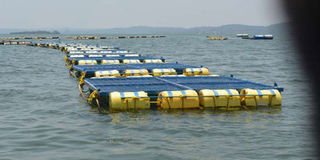Cages restock dwindling fish stock in lake

The floating cages in Lake Victoria, Bondo. They help curb depletion of fish in the lake. PHOTO | FILE
What you need to know:
- Before setting up the cages, it is important one should check the direction of wind.
- For caged fish, according to her, the fish should be offered floating pelleted feeds.
From the shores of Lake Victoria at Anyanga Beach in Bondo, the structures look like bridges linking one section of the water body to another.
But as one moves closer aboard a motorboat, the ‘bridges’ disappear, giving way to cages.
The cages are Winnie Owuor’s farm, where she keeps tilapia in the new farming method that is gaining acceptance in the region.
Winnie says the cages are helping curb depletion of fish in the lake.
“I live 10 metres away from the lake and would always see fishermen get frustrated because there was no fish to catch,” she explains.
“This made me think of whether there is a way we can boost fish stocks in the lake without using the law since past bans had not worked.”
The quest led her to seek training in 2012 on cage fish farming from Western Kenya, an NGO, and Kenya Marine and Fisheries Research Institute (Kmfri).
With the blessings of the National Environment Management Authority (Nema), she started the venture the same year. Before setting up the cages, it is important one should check the direction of wind.
“The cages should be placed in a place with not so strong waves and winds. The area should also be shallow and must be free of aquatic vegetation. The distance from the shore should be about 10 metres.”
She has 60 cages measuring 2 by 2 by 2 metres which she uses to breed fish.
MONOSEX FISH
Each cage hosts 2,000 fish that take between six to seven months to mature.
“I stock each cage with 2,000 fingerlings but during harvesting at six months, I end up with 1,800 fish that I sell at between Sh200 and Sh300. Since they compete for space, the others die,” says Owuor, who started with four cages, with each costing her about Sh100,000.
She rears monosex fish, that is, only the male fingerlings to avoid overbreeding and help the fish mature faster.
To end up with good harvest, she advises that the fingerlings must be managed well.
“The fish must be transported in well-oxygenated containers with water that has the same temperature as that which the fish was in when purchased. It is also advisable to add salt to the container to reduce stress and remove parasites during transportation,” she explains.
She advises farmers to avoid giving poor quality feeds, under-feeding, over-feeding and feeding at the wrong time of the day.
“Overfeeding leads to waste and can cause water decomposition that might lead to diseases and stress to the fish. Under-feeding reduces production and growth.”
For caged fish, according to her, the fish should be offered floating pelleted feeds.
“Floating feeds will be trapped inside the feeding cage and this will give the farmer time to observe the fish as they eat. On the other hand, the sinking feeds will not be eaten by the fish causing decomposition,” she offers, adding farmers should keep good feeding records for better management.
She sells her fish to several hotels in the lake side city and Nairobi.
“I have never marketed my fish but I get referrals every day. I even supply Ronalo Foods in Nairobi,” says Winnie, who has employed 15 workers and has to contend with theft of the fish.
She is currently working on an order to supply 1,000 fish after every four days to a hotel in Nairobi.
She admits that though the enterprise is promising and the returns are rewarding, the business is capital-intensive.
Dr Tsuma Jembe, a Senior Research Scientist at Kmfri, says that the cages are a good idea but they should not be set up in places where they can prevent other people from accessing or using the lake.





